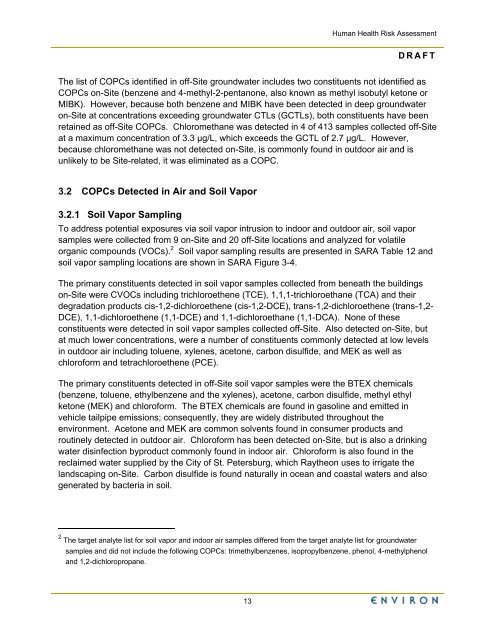Human Health Risk Assessment - Raytheon
Human Health Risk Assessment - Raytheon
Human Health Risk Assessment - Raytheon
Create successful ePaper yourself
Turn your PDF publications into a flip-book with our unique Google optimized e-Paper software.
13<br />
<strong>Human</strong> <strong>Health</strong> <strong>Risk</strong> <strong>Assessment</strong><br />
DRAFT<br />
The list of COPCs identified in off-Site groundwater includes two constituents not identified as<br />
COPCs on-Site (benzene and 4-methyl-2-pentanone, also known as methyl isobutyl ketone or<br />
MIBK). However, because both benzene and MIBK have been detected in deep groundwater<br />
on-Site at concentrations exceeding groundwater CTLs (GCTLs), both constituents have been<br />
retained as off-Site COPCs. Chloromethane was detected in 4 of 413 samples collected off-Site<br />
at a maximum concentration of 3.3 µg/L, which exceeds the GCTL of 2.7 µg/L. However,<br />
because chloromethane was not detected on-Site, is commonly found in outdoor air and is<br />
unlikely to be Site-related, it was eliminated as a COPC.<br />
3.2 COPCs Detected in Air and Soil Vapor<br />
3.2.1 Soil Vapor Sampling<br />
To address potential exposures via soil vapor intrusion to indoor and outdoor air, soil vapor<br />
samples were collected from 9 on-Site and 20 off-Site locations and analyzed for volatile<br />
organic compounds (VOCs). 2 Soil vapor sampling results are presented in SARA Table 12 and<br />
soil vapor sampling locations are shown in SARA Figure 3-4.<br />
The primary constituents detected in soil vapor samples collected from beneath the buildings<br />
on-Site were CVOCs including trichloroethene (TCE), 1,1,1-trichloroethane (TCA) and their<br />
degradation products cis-1,2-dichloroethene (cis-1,2-DCE), trans-1,2-dichloroethene (trans-1,2-<br />
DCE), 1,1-dichloroethene (1,1-DCE) and 1,1-dichloroethane (1,1-DCA). None of these<br />
constituents were detected in soil vapor samples collected off-Site. Also detected on-Site, but<br />
at much lower concentrations, were a number of constituents commonly detected at low levels<br />
in outdoor air including toluene, xylenes, acetone, carbon disulfide, and MEK as well as<br />
chloroform and tetrachloroethene (PCE).<br />
The primary constituents detected in off-Site soil vapor samples were the BTEX chemicals<br />
(benzene, toluene, ethylbenzene and the xylenes), acetone, carbon disulfide, methyl ethyl<br />
ketone (MEK) and chloroform. The BTEX chemicals are found in gasoline and emitted in<br />
vehicle tailpipe emissions; consequently, they are widely distributed throughout the<br />
environment. Acetone and MEK are common solvents found in consumer products and<br />
routinely detected in outdoor air. Chloroform has been detected on-Site, but is also a drinking<br />
water disinfection byproduct commonly found in indoor air. Chloroform is also found in the<br />
reclaimed water supplied by the City of St. Petersburg, which <strong>Raytheon</strong> uses to irrigate the<br />
landscaping on-Site. Carbon disulfide is found naturally in ocean and coastal waters and also<br />
generated by bacteria in soil.<br />
2<br />
The target analyte list for soil vapor and indoor air samples differed from the target analyte list for groundwater<br />
samples and did not include the following COPCs: trimethylbenzenes, isopropylbenzene, phenol, 4-methylphenol<br />
and 1,2-dichloropropane.

















